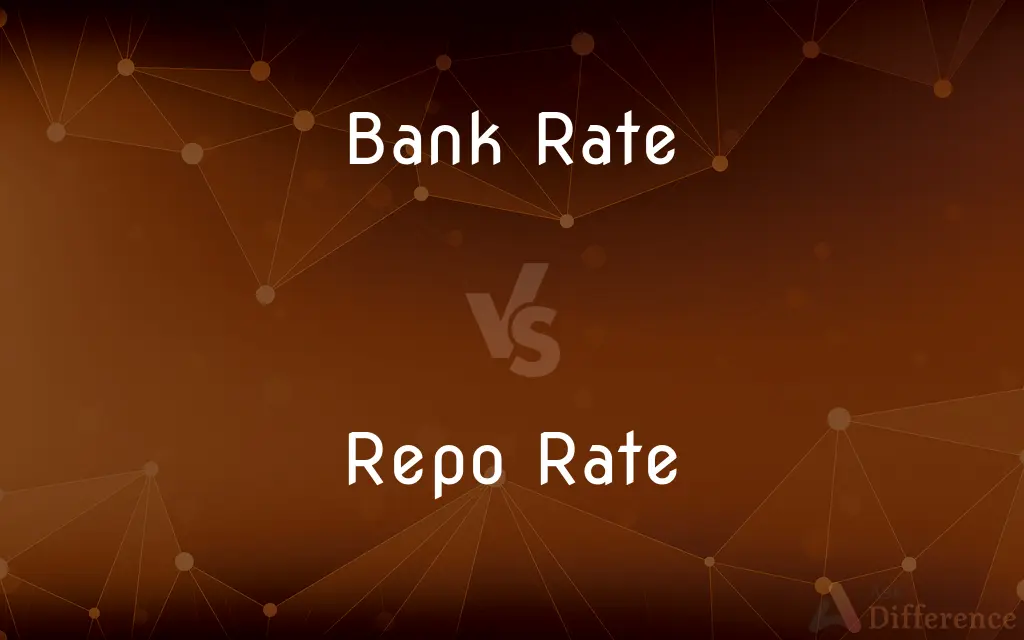Bank Rate vs. Repo Rate — What's the Difference?
By Tayyaba Rehman — Published on October 14, 2023
Bank Rate is the interest central banks charge on loans to commercial banks, while Repo Rate is the rate at which commercial banks borrow money by selling securities to the central bank with an agreement to repurchase them.

Difference Between Bank Rate and Repo Rate
Table of Contents
ADVERTISEMENT
Key Differences
Bank Rate and Repo Rate are two instruments that central banks utilize to manage liquidity and control monetary policy. Bank Rate is the rate at which a central bank lends money to other financial institutions, typically without any collateral. It sets the tone for the cost of borrowing in the economy, influencing lending rates that banks extend to their customers.
Tayyaba Rehman
Oct 14, 2023
The primary difference between Bank Rate and Repo Rate is the involvement of collateral. While the Bank Rate does not involve any collateral, Repo Rate transactions are secured by securities. As such, Bank Rate is typically higher than Repo Rate, as the former carries a higher risk without the backing of collateral.
Tayyaba Rehman
Oct 14, 2023
In essence, while both Bank Rate and Repo Rate serve as mechanisms to control liquidity in the market, they operate in slightly different manners and serve specific functions in the broader monetary policy framework.
Tayyaba Rehman
Oct 14, 2023
Repo Rate, on the other hand, involves a transaction between the central bank and the commercial banks. At the Repo Rate, commercial banks borrow funds by selling securities, usually government bonds, to the central bank with an agreement to repurchase them at a future date. This transaction is essentially a collateralized short-term loan, with the securities acting as collateral.
Tayyaba Rehman
Oct 14, 2023
Both rates are vital tools in the hands of a central bank to influence monetary conditions. By adjusting the Bank Rate and Repo Rate, the central bank can influence the availability of funds in the banking system, thereby affecting borrowing costs, consumer spending, and overall economic activity.
Tayyaba Rehman
Oct 14, 2023
ADVERTISEMENT
Comparison Chart
Definition
Interest rate charged by central banks to banks
Rate at which banks borrow funds by selling securities with a repurchase agreement
Tayyaba Rehman
Oct 14, 2023
Impact on Monetary Policy
Direct influence on lending rates
Influences liquidity in the banking system
Tayyaba Rehman
Oct 14, 2023
ADVERTISEMENT
Definitions
Bank Rate
An uncollateralized lending rate set by the central bank.
An increase in the Bank Rate often leads to higher lending rates for consumers.
Tayyaba Rehman
Oct 02, 2023
Repo Rate
A mechanism for managing short-term liquidity.
Adjustments in the Repo Rate help stabilize money supply in the banking system.
Tayyaba Rehman
Oct 02, 2023
Bank Rate
A benchmark for other interest rates in the economy.
The Bank Rate indirectly affects the cost of borrowing for households and businesses.
Tayyaba Rehman
Oct 02, 2023
Repo Rate
An instrument in the central bank's monetary toolkit.
The central bank uses the Repo Rate to transmit monetary policy signals.
Tayyaba Rehman
Oct 02, 2023
Bank Rate
A tool for influencing economic activity.
By adjusting the Bank Rate, central banks can impact investment and spending decisions.
Tayyaba Rehman
Oct 02, 2023
Repo Rate
A secured borrowing rate set by the central bank.
With securities as collateral, the Repo Rate typically remains lower than the Bank Rate.
Tayyaba Rehman
Oct 02, 2023
Bank Rate
An indicator of the stance of monetary policy.
A decreasing Bank Rate usually suggests a more accommodative monetary policy.
Tayyaba Rehman
Oct 02, 2023
Repo Rate
The interest rate for short-term borrowings using securities as collateral.
The central bank lowered the Repo Rate to infuse more liquidity into the market.
Tayyaba Rehman
Oct 02, 2023
Bank Rate
The rate at which central banks lend money to financial institutions.
The central bank raised the Bank Rate, signaling a tightening monetary policy.
Tayyaba Rehman
Oct 02, 2023
Repo Rate
A rate governing repurchase agreements between banks and the central bank.
When liquidity is tight, banks often turn to borrowing at the Repo Rate.
Tayyaba Rehman
Oct 02, 2023
FAQs
Is the Bank Rate a long-term or short-term rate?
The Bank Rate is typically considered a long-term rate.
Tayyaba Rehman
Oct 14, 2023
How does the Repo Rate function?
The Repo Rate is the rate at which banks borrow funds from the central bank by selling securities with an agreement to repurchase them later.
Tayyaba Rehman
Oct 14, 2023
Why is the Bank Rate usually higher than the Repo Rate?
The Bank Rate is higher due to the lack of collateral, making it riskier than the Repo Rate.
Tayyaba Rehman
Oct 14, 2023
Can the Bank Rate impact consumer loan interest rates?
Yes, changes in the Bank Rate can influence the lending rates offered by banks to consumers.
Tayyaba Rehman
Oct 14, 2023
What happens when the Bank Rate is increased?
An increase in the Bank Rate can lead to higher borrowing costs in the economy.
Tayyaba Rehman
Oct 14, 2023
For what duration are funds typically borrowed at the Repo Rate?
Funds are borrowed at the Repo Rate for short durations, often overnight.
Tayyaba Rehman
Oct 14, 2023
Why do banks enter into repurchase agreements at the Repo Rate?
Banks use repurchase agreements at the Repo Rate to manage short-term liquidity needs.
Tayyaba Rehman
Oct 14, 2023
Can commercial banks borrow at the Bank Rate for any purpose?
Banks can borrow at the Bank Rate for various needs, but primarily to maintain their reserve requirements.
Tayyaba Rehman
Oct 14, 2023
What is the Bank Rate?
The Bank Rate is the interest rate at which central banks lend money to financial institutions without collateral.
Tayyaba Rehman
Oct 14, 2023
How does a change in the Repo Rate affect the economy?
A change in the Repo Rate can influence the liquidity in the banking system, affecting lending rates and economic activity.
Tayyaba Rehman
Oct 14, 2023
Is the Repo Rate a tool for monetary policy?
Yes, central banks adjust the Repo Rate as a part of their monetary policy toolkit.
Tayyaba Rehman
Oct 14, 2023
Does the Bank Rate directly affect deposit rates?
While the Bank Rate influences overall interest rate levels, it doesn't directly set deposit rates.
Tayyaba Rehman
Oct 14, 2023
Which rate involves the use of collateral, Bank Rate or Repo Rate?
The Repo Rate involves the use of securities as collateral.
Tayyaba Rehman
Oct 14, 2023
What’s the key difference between Bank Rate and Repo Rate?
The Bank Rate is an uncollateralized lending rate, while the Repo Rate involves borrowing against securities with a repurchase agreement.
Tayyaba Rehman
Oct 14, 2023
How is the Repo Rate determined?
The Repo Rate is set by the central bank based on monetary policy objectives and economic conditions.
Tayyaba Rehman
Oct 14, 2023
Author Spotlight

Written by
Tayyaba RehmanTayyaba Rehman is a distinguished writer, currently serving as a primary contributor to askdifference.com. As a researcher in semantics and etymology, Tayyaba's passion for the complexity of languages and their distinctions has found a perfect home on the platform. Tayyaba delves into the intricacies of language, distinguishing between commonly confused words and phrases, thereby providing clarity for readers worldwide.

















































